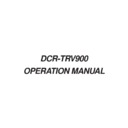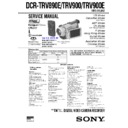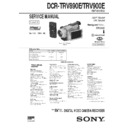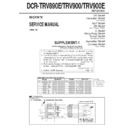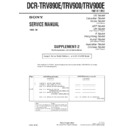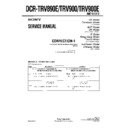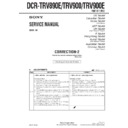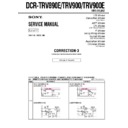Sony DCR-TRV900 Service Manual ▷ View online
4
1-2. System Control Block Description
1-2-1. HI Controller (IC2204)
The HI controller is always monitoring the input signal from the keyboard, LANC,
SIRCS and chime, and issues the corresponding command to mechanism control-
ler, camera controller, OSD, LCD driver and others. The HI controllers and the
DCR-TRV900 system start up in the following sequence.
1 When a battery is installed, the main power is always supplied to the HI
controller as long as the main power is turned on. The DCR-TRV900 entire
system is reset by the HI controller. The HI controller monitors the input
signals all the time.
2 When the POWER ON command is issued from the HI controller as acti-
vated by the key input or any other input signals, the power is supplied to the
mechanism controller, camera controller and digital still controller.
3 Then the respective ICs that are connected to each controller are reset and
start their operations.
1-2-2. Mechanism Controller (IC2401)
…
To be called as mechanism controller hereafter
When the mechanism controller receives the mode transition commands from the
HI controller, it issues the commands to control the I/F that uses the i.- LINK, to
control the tape format (TFD), to control the LINE OUT signal (A01) and to con-
trol I/F (ABC) the microphone input signal. The respective ICs perform their
function in accordance with the commands. Status of these ICs are fed back to the
HI controller through the input controller so that the HI controller monitors and
controls the operating mode at all times.
1-2-3. Camera Controller (IC302)
…
To be called as camera controller hereafter
When the camera controller receives the mode transition commands from the HI
controller, it performs the following functions.
1 EEPROM (IC757) data reading and writing
2 Timing generator (IC204) control
3 VAP (IC302) control
4 FOCUS, ZOOM and ND filter control and motor control
5 Defects compensation and others
2 Timing generator (IC204) control
3 VAP (IC302) control
4 FOCUS, ZOOM and ND filter control and motor control
5 Defects compensation and others
At the same time when the above controls are performed, status of each controller
is fed back to the HI controller through the camera controller.
The mechanism controller and the camera controller are connected in parallel
with respect to the HI controller. Therefore, when any communication between
the mechanism controller and the camera controller is desired, a command needs
to be sent through the HI controller. For example, to send a command from the
mechanism controller to the camera controller, it needs to be sent from the mecha-
nism controller to the HI controller first, then from the HI controller to the camera
controller.
1-2-4. Digital Still Controller (IC751)
…
To be called as digital still controller hereafter
When the digital still controller receives the mode transition commands from the
HI controller, it performs the following functions.
1 It controls the file name and the header information when writing the com-
pressed data into the PC card and others.
2 It controls the file name and the header information when reading the com-
pressed data from the PC card and others.
5
LANC
KEY
EEPROM
Bus
SFD
VFD
ABC
AOI
DAC
EEPROM
LIP
TFD
IC1602
IC1601
IC1200
IC1501
Birds
TG
GCAM
IB
OSD
IC1502
CHIME
IC1602
IC7401
IC2203
FK-4880
(Control Switch Block)
(Control Switch Block)
DISP bus 60 or 50Hz
I/O sync bus 60Hz/50Hz
Camera bus 50/60Hz
VSP bus 150Hz
DRS bus 150Hz
IC2204
HI Controller
LCD driver
TRX
TRF
A/D (VAP)
EEPROM
IC1814
IC1900
IC300
IC204
IC203
IC302
IC301
IC760
IC1600
IC1501
IC2001
IC1402
IC2002
IC2404
BBI
EVF DAC
LCD DAC
IC5001, 5102,
5502
5502
IC2401
Mechanism Controller
IC302
Camera Controller
IC751
Digital Still Controller
SIRCS
1-2-5. System Control Block Diagram
6
1-3. Clock Signal Block Description
The sampling clock frequency systems of the DCR-TRV900 are classified into
the followings.
(1) For the camera system and external video input system: 13.5 MHz
→
The sampling clock frequency for the camera signal that is specified by
the DV format.
(2) For the signal compression system: 18.0 MHz
→
As the clock frequency for the Y-signal data and the C-signal data is 13.5
MHz, a higher clock frequency of 18.0 MHz is used to compress them
into a single data.
(3) i. LINK system: 98.3 MHz
→
The sampling clock frequency for the DV terminal is specified to be 98.3
MHz.
(4) For interfacing the record system: 8.37 MHz
→
Because the record circuit is located in a separate circuit board, and to
ensure the interfacing, this sampling frequency is used.
(5) For record system: 41.85 MHz
(6) For the playback signal processing system: 20.925 MHz
→
The frequency that is suited for processing the playback signal, is se-
lected.
(7) For VIDEO OUT: 27.0 MHz
→
The over-sampling frequency is used to improve the waveform character-
istics of the video LINE OUT signal.
7
Clock Signal Block Description Diagram
IR
VIDEO-IN
Line-in
Decoder
Decoder
H-PLL
LINE-13.5MHz
BBI
2.1Vmin
AFCK
CAM-13.5MHz
A/D
BIR DS
SPCK
2
1
27.0MHz
SYSCK
TG
Divide
-by-2
-by-2
2.7 Vmin
2.7 Vmin
VCK
CCD
13.5 MHz is not supplied
when using CG of 6.75 MHz.
when using CG of 6.75 MHz.
13.5 MHz is supplied
the caseof DEKA PYRA.
the caseof DEKA PYRA.
EVF LCD
panel
CG
External
features
3
4
5
3
VCK
Built-in PLL
×
4/3
×
2
TRCK0
2.7Vmin
TRCK1
1
2
3
VFD
SFD
UNLOCKD-REC
Divide-by
-[3
+
21/35]
(27.0MHz)
24.576MHz
256fs
approx. 24.576MHz
VIDEO-OUT
fsc of NTSC=3.53MHz
(In the PAL mode also)
2.7Vmin
DV terminal
LIP
Built-in PLL
×
4
24.576MHz
JC-18.0MHz
4
TFD
1.8Vmin
REC-8.37MHz
CRCK
Divide-by-4
Built-in PLL
×
31/10
TRX
REC-41.85 MHz
Divide-by-2
Divide-by-5
1.8Vmin
HPCK
PB-20.925MHzr
PB-41.85MHz
r
TUTS
(Not used)
BCK1
BCK0
2.7Vmin
64fsr
=3.072MHz (In case of 48 kHz)
=2.048MHz (In case of 32 kHz)
=3.072MHz (In case of 48 kHz)
=2.048MHz (In case of 32 kHz)
AUDIO-PLL
×
512fs
(In case of
48 kHz)
48 kHz)
×
768fs
(In case of
32 kHz)
32 kHz)
Divide-by-2
(In case of
48 kHz)
Divide-by-3
(In case of
32 kHz)
(In case of
48 kHz)
Divide-by-3
(In case of
32 kHz)
ADA
ABC
..
..
AUDIO-IN & OUT
1.8 Vmin. and 2.7 Vmin. shown in the illustration are the clock voltage.
The VFD (27.0 MHz) and LIP (98.304 MHz) are used only inside of each IC.
Clock of the four systems that are LINE - 13.5 MHz
r
, 256 fs
r
, PB - 8.37 MHz
r
and PB - 41.35 MHz
r
deviate by
±
several percents. Other clocks have the fixed frequency.
Same as C1 of
φ
2
Frame PLL of the digital system.
Frame pulse
(30/1.001 Hz in NTSC.
25 Hz in PAL)
(30/1.001 Hz in NTSC.
25 Hz in PAL)
Track pulse
(150/1.001 Hz in NTSC.
150 Hz in PAL)
(150/1.001 Hz in NTSC.
150 Hz in PAL)
FRR
T
, TRR
T
Mechanism
controller
DRUM
TRW
TRF
1.8Vmin
RECCK
1.8Vmin
PBCK
PB-PLL
(built-in)
13.5 MHz from TG
(98.304MHz)

